
Original Link: https://www.anandtech.com/show/6968/puget-systems-genesis-ii-quiet-workstation-review
Puget Systems Genesis II Quiet Workstation Review
by Dustin Sklavos on May 22, 2013 12:01 AM EST- Posted in
- Systems
- Xeon
- Puget Systems
- Workstation
- desktops
_678x452.jpg)
Introducing the Puget Systems Genesis II Quiet
Over the past two years, we've seen boutiques start to really stratify and carve out their own territory and turf. Puget Systems had their carved out pretty much since I started working for AnandTech, though: they're not quite as expensive as Falcon Northwest, but they definitely charge a premium over other boutiques. In exchange, you get hardware that's been carefully selected to be as reliable as possible. I've discussed their reliability metrics at length with their CEO, Jon Bach, and they're thorough to say the least, often singling out individual production runs as being problematic. The result is that the component selection they offer is much narrower than you might find at other boutiques, but essentially geared towards ensuring you never have to send your system in for service.
.jpg)
That's especially important when you're dealing with a professional grade workstation. While I've typically been impressed by the quality of the towers Puget Systems has sent me, workstations from boutiques are another matter entirely. It's my understanding workstations are responsible for a healthy amount of business for boutiques, but while a boutique tower is almost always going to be a better long term deal than buying a conventional tower from a mainstream vendor, workstations have greater expectations placed on them. They need to be more reliable, and quality of service and customer care is a serious issue. Without the infrastructure of a Dell or an HP, service becomes a real fly in the ointment, and every other part of the experience has to be good enough to make up for this.
Though Puget Systems is no stranger to workstations, the build we have on hand today had a journey to fruition that I'd like to think I had some small part in. The Puget Serenity is a dead silent but very powerful tower, and Mr. Bach and I had gone back and forth about designing the quietest full fat workstation we could. In the interim I vanished under a sea of work, but the concept turned into a product in my absence. Today I'm reviewing that product: the Genesis II Quiet.
| Puget Systems Genesis II Quiet Specifications | |
| Chassis | Fractal Design Define XL R2 |
| Processor |
2x Intel Xeon E5-2670 (8x2.6GHz, Turbo to 3.3GHz, 32nm, 20MB L3, 115W) |
| Motherboard | ASUS Z9PE-D8 WS |
| Memory | 8x8GB Kingston ECC DDR3-1600 (four per CPU) |
| Graphics |
ASUS DirectCU II NVIDIA GeForce GTX 670 2GB GDDR5 (1344 CUDA Cores, 915MHz/980MHz/3GHz core/boost/RAM, 256-bit memory bus) |
| Hard Drive(s) |
Samsung SSD 840 Pro 256GB SATA 6Gbps SSD Western Digital Caviar Green 3TB SATA 6Gbps HDD |
| Optical Drive(s) | ASUS BW-12B1ST Blu-ray writer |
| Power Supply | Seasonic X 850W 80 Plus Gold |
| Networking | 2x Intel 82574L Gigabit Ethernet |
| Audio |
Realtek ALC899 Speaker, line-in, mic, and surround jacks |
| Front Side |
Optical drive Card reader 1x USB 3.0 |
| Top Side |
2x USB 2.0 2x USB 3.0 Headphone and mic jacks |
| Back Side |
PS/2 6x USB 2.0 Optical out 2x Gigabit ethernet 2x USB 3.0 Mic, line-in, stereo, and surround jacks 2x Serial (add-on bracket) 2x DVI-D (GTX 670) HDMI (GTX 670) DisplayPort (GTX 670) 2x USB 3.0 (add-on bracket) 4x USB 2.0 (add-on bracket) eSATA (add-on bracket) 6-pin FireWire (add-on bracket) |
| Operating System | Windows 8 Pro 64-bit |
| Dimensions |
9.13" x 22.01" x 22.04" 232mm x 559mm x 560mm ~60 lbs |
| Extras |
Card reader 80 Plus Gold PSU Gelid Tranquilo v2 CPU coolers Optimized for silence |
| Warranty | Lifetime labor and tech support, 1-year parts |
| Pricing |
Starts at $3,088 Review system configured at $7,602 |
Obviously a dual-octalcore workstation is not for the faint of heart or bank account. The Genesis II Quiet is a strictly dual-CPU affair, and the dual Sandy Bridge-EP Intel Xeons in our review unit are the fastest Puget Systems is willing to offer: two Xeon E5-2670s, eight cores apiece clocking at a nominal 2.6GHz but able to turbo up to 3GHz on eight or seven cores, 3.1GHz on five or six cores, 3.2GHz on three or four cores, and 3.3GHz on one or two cores. These clocks would ordinarily be unimpressive on a quad core, but we're dealing with a tremendous amount of threaded performance here (32 logical threads in all), and all of this performance is under a TDP of 115 watts. That means that before we get to anything else, we're looking at 230W of CPU horsepower alone.
Each socket only has four memory slots to populate all four memory channels, and our review unit is running 32GB of Kingston ECC DDR3-1600 per socket. 128GB and 256GB configurations are available, but they're not cheap by any stretch of the imagination owing to their extremely high density DIMMs. Meanwhile, system storage is handled by a capable Samsung 840 Pro SSD (256GB) while mass storage is handled by the slow but low-power Western Digital Caviar Green (3TB).
There are a trio of decisions that I think are worth mentioning. Up until this point, nothing's been too out of the ordinary for a workstation.
The first is Puget Systems opting to use a Fractal Design Define XL R2 for the chassis. I reviewed this case fairly recently and I think it's a good fit, but as far back as I can remember Puget Systems has been a predominately Antec house. Yet for dual-CPU systems, Puget is going with the Define XL R2, pointing to both a hole in Antec's lineup and potentially the greater fact that Antec has been extremely sluggish in addressing the chassis market it used to lead. In a way, this feels like a subtle indicator of something we may already have known: the Fractal Design Define line of cases is essentially the successor to the P180 series legacy.
The second are the pair of Gelid Tranquilo v2 coolers used for the CPUs, undoubtedly to substantially reduce noise over Intel stock cooling. Since these tower coolers are capable of dissipating much more heat than they're going to get from the Xeons, Puget Systems is able to run their fans at very low speeds, keeping the processors cool without generating noise. There's no liquid cooling at all in the Genesis II Quiet: while liquid cooling can be excellent for hitting low noise levels, true silent running is really only achievable with air cooling. Additionally, air coolers are going to be more reliable long term than a liquid cooling loop and require less service. It's a win-win.
Finally, while the ASUS GeForce GTX 670 is certainly a very quiet card, it's also an extremely oddball choice for a workstation. If we were looking for pure compute performance at a low price tag, an AMD Radeon HD 7900 series would be a better choice; for genuine workstation tasks, consumer-grade GPUs are out of the question. This will unfortunately put a nasty damper on the Genesis II Quiet's performance later on. Note that you can configure the Genesis II Quiet with proper workstation cards, and naturally they're pretty expensive.
Application and Futuremark Performance
As the mobile benchmarking suite has been updated recently, the desktop suite is going right along with it. Thus there may not be quite as many comparison points between the Puget Systems Genesis II Quiet as we'd like, but enough to at least get a feel for how the system performs.
This is the second dual-CPU workstation we've tested; the Lenovo ThinkStation D30 is the first, and features two faster Xeons owing to their higher 150W TDPs.
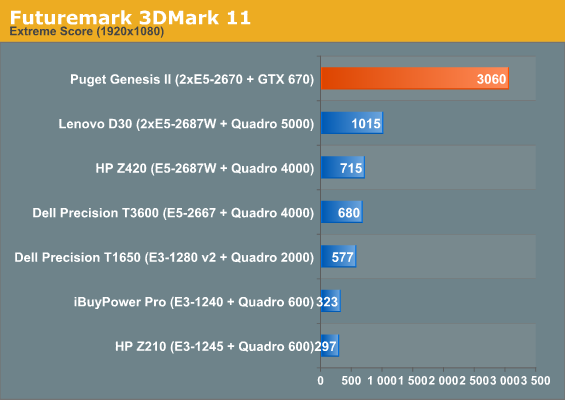
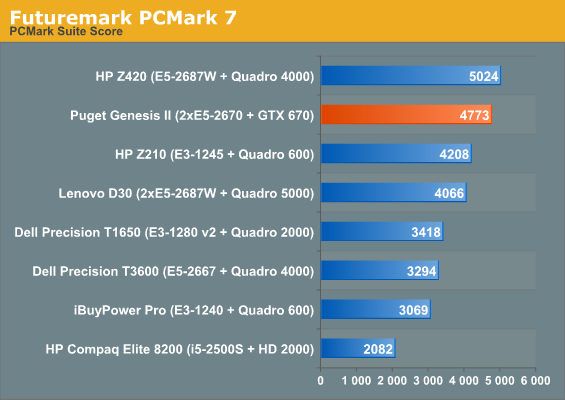
In terms of pure graphics performance, the GeForce GTX 670 is miles ahead of the anemic stripped down GF100 powering the Quadro 5000 in the Lenovo D30, but remember that this is a consumer card competing with a series of workstation cards. PCMark continues to be limited principally by storage performance and clock speed.
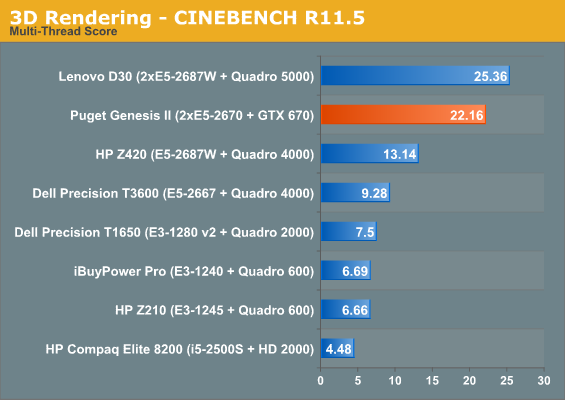
In multi-threaded testing, everything lines up as it ought to. The two octalcore Xeons in the Genesis II are incredibly fast, but the D30's are faster.
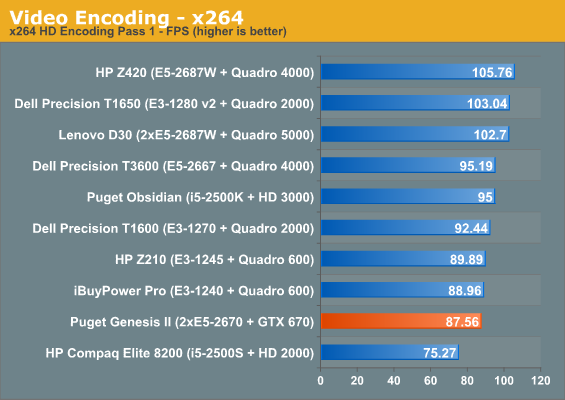
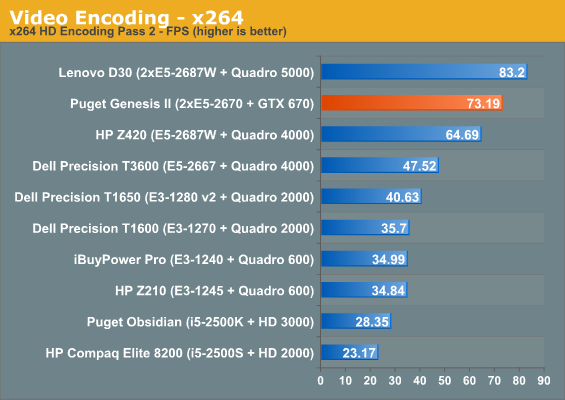
Our original x264 encoding test demonstrates about what we'd expect. The initial pass is not as heavily threaded as the second, and benefits more from high clock speeds than copious core counts. When we can leverage the additional throughput in the second pass, the Genesis II surges forward.
This is as good a time as any to point out why $4,000 of eight core Xeons are for very specific tasks, and why we haven't seen (and may not see for some time) an enthusiast-class octalcore i7. More cores mean more heat, which means reduced clocks. Six cores (twelve threads) have been, in my experience, about the limit for what a consumer or even prosumer can really take advantage of, and quad cores really are excellent for almost everyone in that class. This isn't one of those "better to have it and not need it than need it and not have it" situations, either; as the test results for x264 and PCMark 7 demonstrate, if your workload can't take advantage of the extra cores you've effectively left performance on the table by going for more cores instead of fewer, faster ones. That's why you're seeing dual-CPU workstations but virtually no dual-CPU enthusiast machines.
Workstation Performance
Unfortunately, despite its workstation pedigree, the Puget Systems Genesis II Quiet suffers mightily in SPECviewperf due to its consumer-grade GeForce GTX 670. For gaming that card is fine, but workstation applications place higher and different demands on the graphics hardware and drivers. As you'll see, though, the Genesis II Quiet will need a workstation card to fulfill its potential.
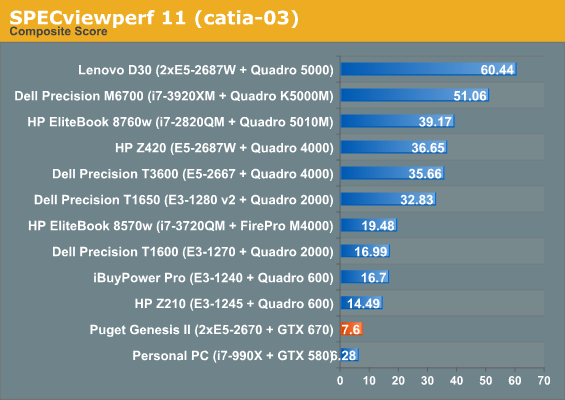
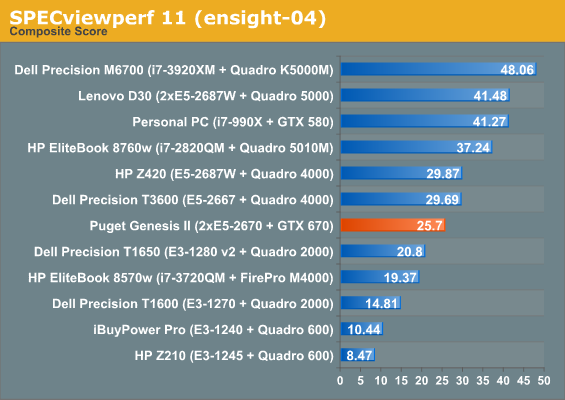
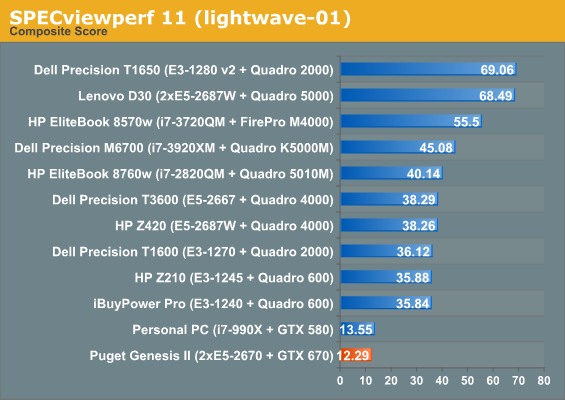

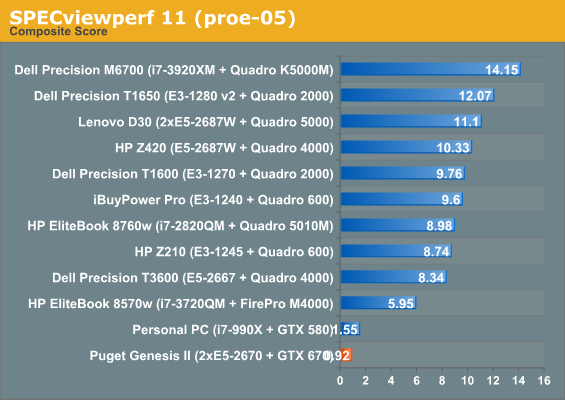
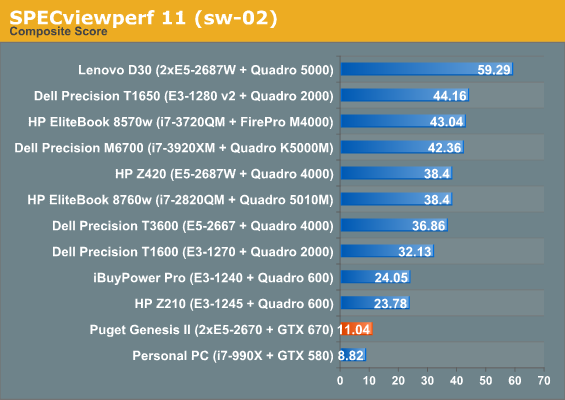
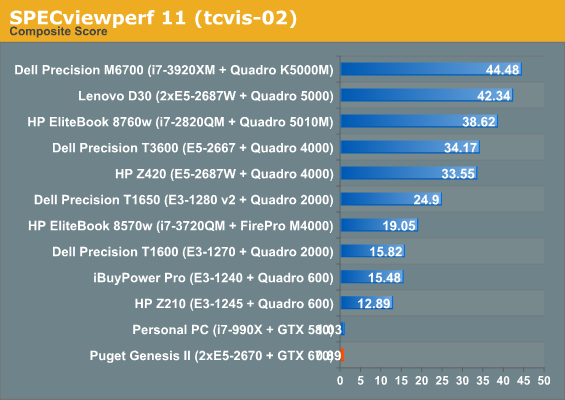
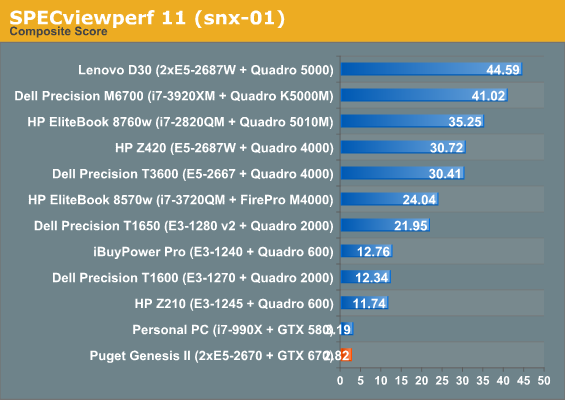
It's not even a little bit slower, it's worlds slower. Compare the performance of the GTX 670 to even the entry-level, $145 Quadro 600. With rare exception, even 96 last-generation CUDA cores are able to produce tremendous performance gains with the right drivers over a beast like the GTX 670. Even if you're a prosumer, you owe it to yourself to jump over to a workstation card if your workload demands one.
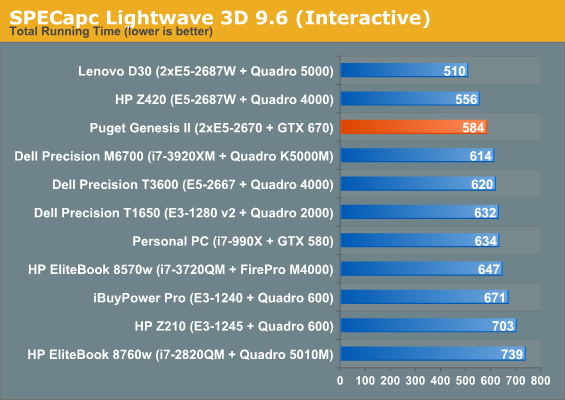
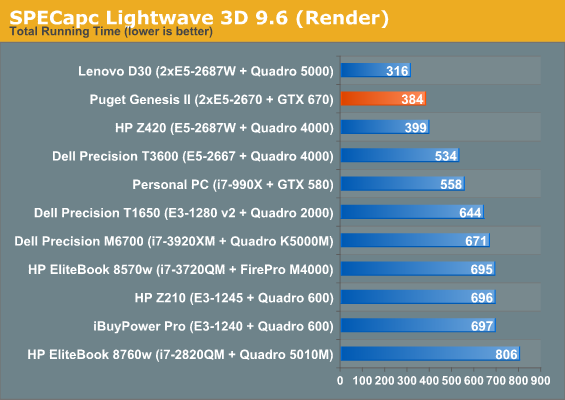
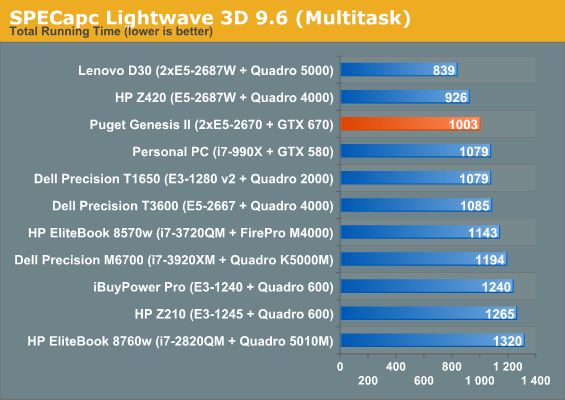
Lightwave is a bit kinder to the Genesis II Quiet, limited primarily by CPU performance. There's a point of diminishing returns that Lightwave reaches, and it still seems to respond well to high core clocks. Still, if you use Lightwave, you owe it to yourself to run an octalcore processor. Whether or not you need a second one is debatable, but at least a single one is enough to produce a jump in performance.
Build Quality
It's hard to really find fault with the Puget Systems Genesis II Quiet's assembly. Puget Systems hardware has always been well put together, and the Genesis II Quiet is no different. They started with the Fractal Design Define XL R2, but in the process they made some changes and additions in order to maximize the overall cooling efficiency and keep noise levels down.
.jpg)
For starters, the stock cooling system has been revamped. Puget Systems removed the front intake fans entirely and instead placed a single intake on the bottom of the enclosure. The rear fan continues to operate as an exhaust, but they've removed the panels that block the top two 140mm fan vents. Those vents are unoccupied, but the Gelid Tranquilo v2 CPU coolers are oriented to draw air directly from the bottom and up out of the top and rear of the case. You'll see that this unusual cooling design does work and work well.
They've also taken advantage of the headers on the motherboard and attached just about as many brackets as they conceivably could, resulting in an embarrassment of ports on the back. Anything you want to connect to the Genesis II Quiet, you can.
Noise and Heat
If the Puget Systems Genesis II Quiet did a poor job of keeping thermals and noise down it would be a severe black mark, but thankfully the system is as well engineered as one would hope and expect. Noise levels border on inaudible; you have to put your ear up to the vents to really hear the Genesis II running, and there's no appreciable difference between idle and load noise. This is easily the quietest workstation I've tested, an impressive feat when you consider most high end workstations from major vendors are specifically designed to run quietly.
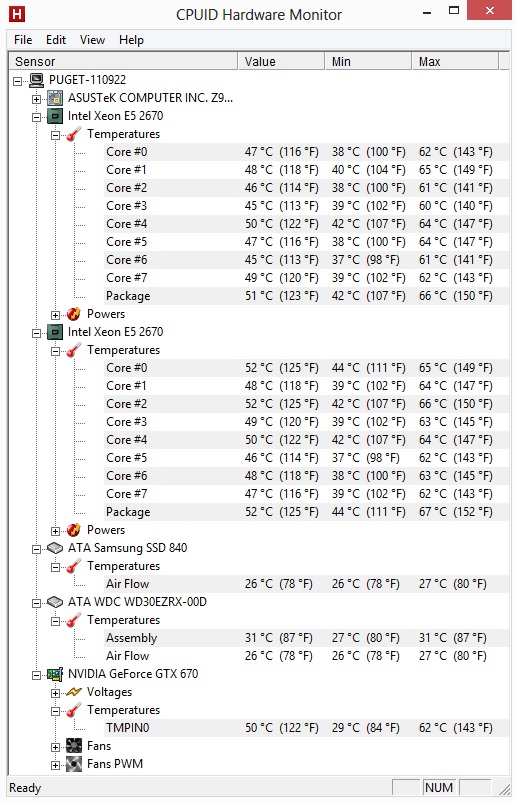
The thermal design of the Genesis II Quiet pays big, big dividends, too. No component inside the enclosure reaches 70C under sustained load. This is at least a substantial victory for Puget Systems, as this build is exceptionally efficient thermally and acoustically.
Power Consumption
Given that we're running two 115W processors, it's reasonable to expect that power consumption on the Puget Systems Genesis II Quiet is going to be a bit higher than the norm.
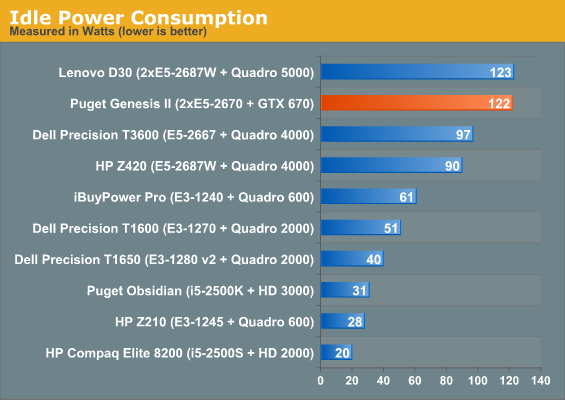
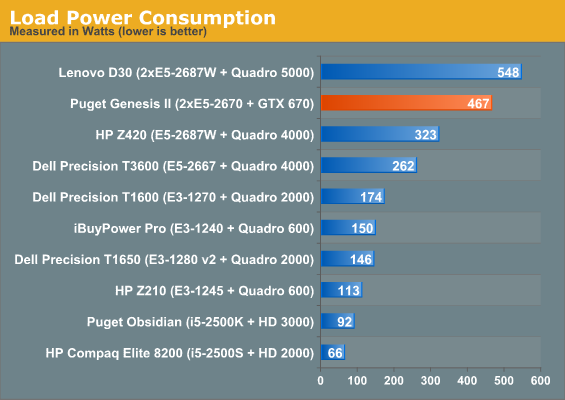
The Genesis II idles high and runs a high load draw, and both are to be expected. This is another reason why you need to be certain you need the high threaded throughput of dual processors like this before going down this road; single-CPU systems are much more frugal, especially when you get to hexacores on down to quads. This isn't bad power consumption, but it's notable; for the same idle power budget, you can power my desktop with a substantially overclocked i7-3770K and GTX 680 along with two IPS panels and a set of speakers. There isn't anything Puget Systems could really do under these circumstances, it's just the nature of a dual-CPU beast.
Conclusion: Tough Sell, Depending
There are no bad products, only bad prices, and that adage holds true with the Puget Systems Genesis II Quiet. In the process, though, Puget Systems has more mitigating factors to contend with beyond just delivering a price and performance competitive product. The nature of the workstation market puts increased demands on both the product and the vendor.
First, though, in terms of the tower itself, Puget brings a lot to the table. Top to bottom, the components included are the kind of high quality that you'd expect. As I mentioned previously, this is the quietest workstation I've ever tested, an impressive feat when you look at the tremendous amount of performance on tap from the two CPUs. A series of intelligent component choices, smart engineering of the chassis, and an overall clean build allow the Genesis II Quiet to very effectively achieve what Puget Systems set out to do: build an incredibly fast system that produces virtually no noise. That everything runs as cool as it does is just an added bonus.
Where things get dicey is when you compare the Genesis II Quiet to workstations from HP, Dell, and Lenovo. At this time I'm keen to point out that HP's enterprise website is hands down the worst one out there, with absolutely lousy access times and an abysmal layout. This has been true for a long time and I'm mystified as to why it's never been corrected, so if you want to order something today, you may have to forego the HP Z820. If you do manage to get through their site, though, a comparable Z820 comes in at $9,927, or $7,942 after their coupon code is applied. That's $300 more, but in exchange you get a workstation GPU to start with and three years of enterprise class warranty coverage and support.
.jpg)
Unsurprisingly, Dell eats the competition alive with a workstation sporting two slightly faster processors at $6,972. Again, you get an entry-level workstation card and three years of enterprise class warranty coverage and support standard. You also get Dell's RMT (Reliable Memory Technology), unique to them, which isolates and cordons off bad memory while maintaining uptime. And both Dell and HP have repair depots sprinkled liberally throughout the country, something Puget Systems is unfortunately just too small to offer. Lenovo's the only company that can't compete; they start at over $10k for a similar configuration, and though you get the same three-year parts and on-site labor warranty, there's no reason to spend the extra money.
At this point I'm being slightly unfair to Puget Systems; if you cut $150 from the cost of the Genesis II Quiet, you can get an entry-level workstation card and be on your way, and the build itself has a lot to recommend it. The problem is that they have find some way to beat the three-year standard warranty with on-site repair that major vendors offer, and just having a computer that runs silently with higher quality parts isn't going to cut it. I understand why they only offer a one-year warranty on their consumer machines; offering a parts warranty for two to three years may be industry standard, but technology rollover in the consumer PC industry is fast and it may be difficult if not impossible to source replacement hardware. On the enterprise side, this doesn't really hold water; if you're selling a workstation, it needs a three-year warranty, period, and if you're going to cite enhanced reliability on your component choices then you need to be willing to back it up even if only for your customer's peace of mind.
I don't know that anything can be done about the price; bigger vendors like HP and Dell get sweetheart deals that can make it difficult to compete on that front. And it's tough to compete with companies that large that can just set up supply depots and send repair technicians out into the field all over the country. I feel like Puget Systems need to at least up their parts warranty to three years on the Genesis II Quiet Edition; a workstation that starts at $3,000 and only goes up from there has no business with just a one year warranty. If they can do that, I can find a reason to recommend the otherwise excellent Genesis II.

_thumb.jpg)
_thumb.jpg)
_thumb.jpg)
_thumb.jpg)






